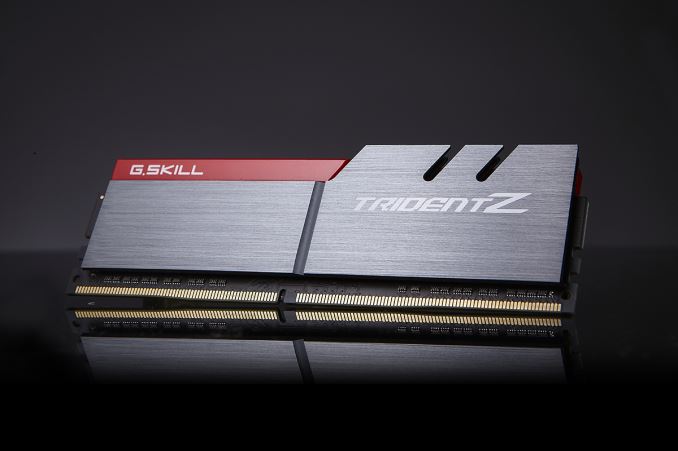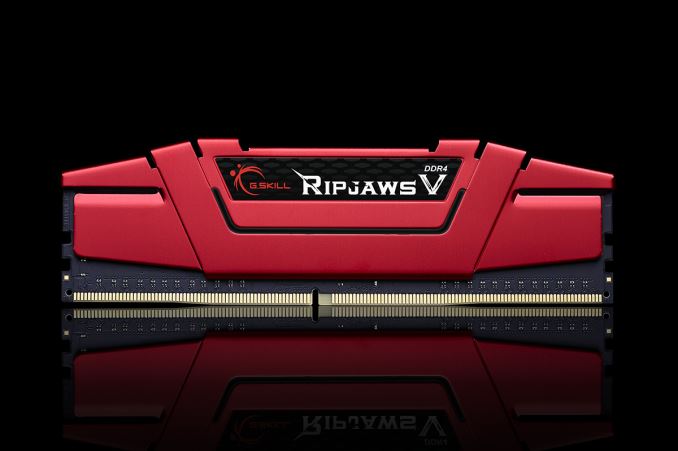G.Skill Announces DDR4-4000 and DRAM in Dual Channel Kits
by Ian Cutress on July 29, 2015 9:43 AM EST
At this point in time, the only commercial platform that runs DDR4 is the Haswell-E processor combined with the X99 chipset. For that platform, the processor has a quad-channel memory controller and in order to extract the best performance, four memory modules are needed – we published a large breakdown on the effect of the DDR4 memory speed on this platform earlier in the year.
Despite this, G.Skill is today announcing its upcoming memory kits – specifically ‘designed for 6th Gen Intel Core Processors and Z170 motherboards’, or what the rest of us calls ‘Skylake’. These new kits fall into two series called ‘Trident Z’ and ‘Ripjaws V’, with the Trident line being typically faster than Ripjaws although there will be crossover. Memory companies usually do this in order to enable users who prefer one style over the other but still want a certain speed.
These new kits, not only being announced seemingly early, also seem to break DRAM speed barriers for kits in the market. The new Skylake platform is expected to have a memory rating equivalent for the JEDEC specifications for DDR4, which is DDR4-2133 at subtimings of 15-15-15. One of the new kits pushes through to DDR4-4000, almost doubling the frequency of the JEDEC standard, although with a slightly slower sub-timings of 19-25-25.
These will be available only in 2x4 GB form, with pricing not announced. All Trident Z modules will run at the higher DDR4 voltage standard of 1.35 volts except this DDR4-4000 kit, which will require 1.35-1.40 volts. It would seem that the ICs used here are hand picked and tested, and thus each kit might have slightly different voltage requirements and thus uniquely programmed.
The other design is the Ripjaws V, which will cover most frequencies from DDR4-2133 but also in the higher capacity configurations. I am told that G.Skill is ready to deploy a number of kits with 16GB modules, affording 2x16 and 4x16 kits giving 32GB and 64GB of DRAM respectively.
Ripjaws V will be available in red, blue, silver, gray and black. The 16GB modules are specifically using Samsung ICs, and will be available up to DDR4-3200.
The Trident Z line is a lot less spiky than the previous Trident modules for good reason - personally I obtained injuries using it over the years because it was simply sharp. The new line avoids this, but also enables G.Skill to add its name to the top of the module, allowing modders to indicate exactly what modules are being used.
Given this press release today, and what we’ve heard on the grapevine, it seems that Skylake is promising to be a super platform for DRAM in terms of both capacity and speed. Needless to say, pricing and specific release dates were not provided. I suspect other companies will follow with their dual channel kit announcements soon given this release today.
Source: G.Skill




















25 Comments
View All Comments
jjj - Wednesday, July 29, 2015 - link
Any clue if Samsung is using TSV in all it's DDR4 (so here too) , wondering about reliability and impact on OC potential, can't say i've seen any data on that topic.DanNeely - Wednesday, July 29, 2015 - link
Looking at those timings I'm wondering if the DDR4-3800 kit won't actually be faster. They really had to loosen the timings for those last 200 MHz.ImSpartacus - Wednesday, July 29, 2015 - link
Seems like that's always the never ending question, eh? Tight timings or high clocks?DanNeely - Wednesday, July 29, 2015 - link
Normally within a series of products it's a fairly smooth continuum with actual latency periods roughly constant; the 4000 module had to really lengthen the latencies though to get those last few MHz out of the chips.littlebitstrouds - Wednesday, July 29, 2015 - link
So, are we going to see a study, like always, showing all these speed bumps really equates to 1-2% increases in performances?Pissedoffyouth - Wednesday, July 29, 2015 - link
I can't wait for the APUs to get this, will be awesomemeacupla - Thursday, July 30, 2015 - link
why? APUs are going to get HBM, which is a lot faster than DDR4Alexvrb - Thursday, July 30, 2015 - link
DDR4 is here now and price isn't bad considering you have to buy RAM regardless. Why not use the faster stuff now and switch to HBM when it makes sense? At this point in time integrating their APU designs with an interposer and HBM probably won't be cheap. You can slap it in a high-end graphics card today, but how about a sub-$200 APU?Personally I wouldn't be surprised if they didn't release HBM-equipped APUs until Zen. I would like to be wrong, and have them at least release a few high-end HBM models for laptops and other compact form factors, where a graphics upgrade isn't a drop-in card away.
yuhong - Friday, July 31, 2015 - link
Not next year's AMD APUs, I think.Impulses - Wednesday, July 29, 2015 - link
AT/Ian already did one for DDR4 on Haswell... There's even more stratospheric speeds now but I don't l doubt it matters, tho there were edge cases where the difference was as much as 10% (not synthetic either).